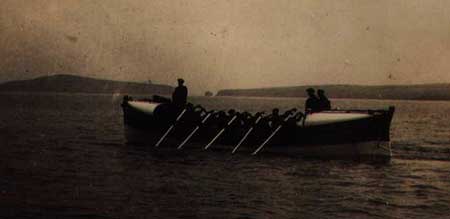|
he following is a true story my father Thomas Bowen told me. From his reminiscences I wrote this piece and it was put in the local annual regatta program for people to read, said Tony Bowen.
On 13th March 1919, the SS Conservator of London was bound from Waterford, Ireland to Newport, Gwent. Her Skipper was Captain Percy John. She put out from Waterford and encountered a severe gale blowing from the west to northwest, which drove her across the Irish Sea and into Cardigan Bay.
She eventually managed to anchor in a dangerous position off the Black Rocks at Poppit Sands. Captain John semaphored a signal to the coastguard station and rockets were sent up to call out the crew of the Elizabeth Austin.
The lifeboat was launched into a raging sea and two oars were broken before she cleared the land. The coxswain - THOMAS BOWEN - anchored the lifeboat to seaward of the plunging countered stern of the vessel.
As the stern reared up and drew the lifeboat in, the crew of the Conservator dropped down into the lifeboat, two at a time. When all ten crew were rescued, the anchor rope was buoyed and cast off, to be picked up in calmer weather.
Using the mizzen sail, the lifeboat was tacked across the bay to Cardigan Bar. Streaming a sea anchor astern, the coxswain took her into the heavy seas on the bar, well away from the rocky cliffs of Gwbert.
She grounded and heeled over onto her bilge keel and almost immediately; a tremendous sea crashed over her, refloated her and hurled her on over the bar and into the river.
Soon they were up the river in calm water, where dry tobacco was brought out and pipes lit for the survivors. Crowds watched the lifeboat proceed up the river, with the crew rowing in time to the coxswain tapping the thwart with a small wooden marlinespike. 
The blue and white lifeboat Elizabeth Austin, powered by oars, used in the daring rescue of 1919.
On reaching the quay in Cardigan, the crew - who looked the worse for wear, were taken to the Black Lion Hotel, where, after being given dry clothes and refreshments, stayed the night.
The lifeboat left Cardigan to the cheers of the watching crowd, once again rowing in perfect time to the tap, tap or the marlinespike. The lifeboat was anchored off the Ferry Inn, at St Dogmaels, until the gale abated and then taken back to the lifeboat house.
For this rescue, coxswain Bowen was awarded the RNLI bronze medal.
Five years later - in 1924 - two Cardigan sailors, cousins Will Rees, Pwllhai and Will Philips, Netpool Cottage, were ashore in Karachi, in India, where they met up with Chris Chambers of Bristol, one of the sailors rescued from the Conservator. A small world! 
Thomas Bowen's boat, the Dancer. The top of her mast was painted gold, as it was the closest part of her to heaven!
Tony Bowen, St Dogmaels, 2001
| |


